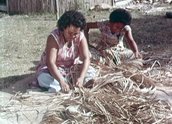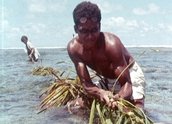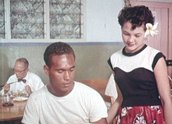


Two Men of Fiji (1959)
Synopsis
This documentary, made by the Shell Film Unit, follows the story of two young Fijian men who leave their native village on one of the Lau group of islands for the city of Suva on Fiji’s main island. For one of them, city life is not all he had imagined it would be.
Curator’s notes
Set on one of Fiji’s smaller islands (one of the Lau Group of 57 islands), the first half of the film surveys semi-traditional Fijian village life and establishes the two main characters, Jale and Adriu. Voiced by Fijian Ravuama Vunivalu, the narrator is an ‘insider’ speaking about his own people and experiences – a departure from other Shell documentaries that are narrated by a dispassionate outside voice. However, while the observations of village life are real, the story of the film’s protagonists has been cleverly scripted by Shell Film Unit director Brett Porter. It is important to remember, too, that at the time this documentary was made, Fiji was still a colony of the Commonwealth.
Fijian village life in Two Men of Fiji is experienced through the eyes of cousins Jale and Adriu. It is described as an idyllic community-based lifestyle where each member of the community has his or her designated roles within their social group, and all contribute to activities such as thatching a house, or catching fish. Life in Suva, depicted in the final third of the film contrasts with this image of primitive harmony. Jale’s experiences in the capital are isolating and he finds it difficult to adjust to a life that centres on the individual, where you need to buy everything, and where experiences are new and unfamiliar. Jale’s adventure to the city ends with his decision to return to his village and re-join his community.
The film touches on the workings of the village economy (the villagers rely on the export of copra, or dried flesh of the coconut, for their livelihood); the kin relationships and their associated customs; gold and mineral exports; Fiji’s colonial status in the Pacific: the Chinese and Indian ethnic minorities living and working in Suva; and the growing tourism industry in Fiji. This final point may be where Shell’s interests indirectly lie. With increased tourism comes a boost for the aviation industry (Qantas co-operated with the making of this documentary) and the industry’s suppliers, including Shell. The story of Jale and his experiences in and away from his village projects Fiji as a country which contains both traditional and modern aspects of Fijian culture (however crudely the contrasts are projected here). It remains, however, an insight into 1950s attitudes towards our ‘exotic’ neighbours in the Pacific at a time when most Australians would not have travelled through the region.
Overall this is a complex documentary in which issues of representation, colonialism and portrayals of culture are all bubbling under the surface.
- Overview
- Curator’s notes
- Video 3 clips
- Principal credits
- Find a copy
- Make a comment
- Map
- Add your review



